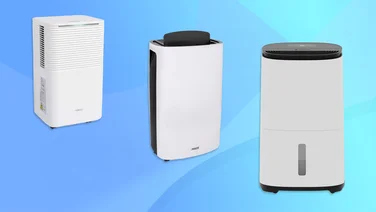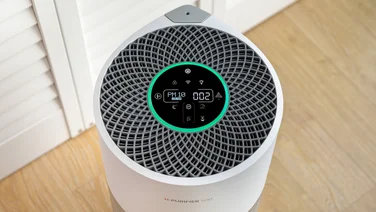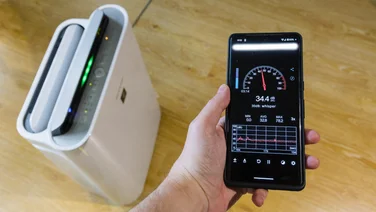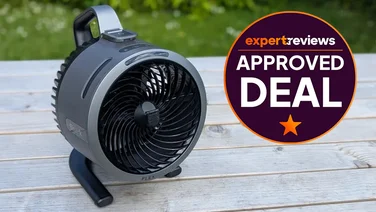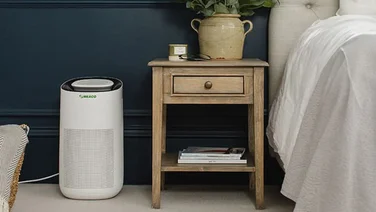To help us provide you with free impartial advice, we may earn a commission if you buy through links on our site. Learn more












- Reasonably powerful
- Very stylish
- Low power consumption
- Expensive
- No vertical oscillation
- Tiny remote control
When Dyson designed the original bladeless fan, it was a revelation and it has since spawned thousands of copycats. The company has built on that original design many times since, producing fans that also heat, purify and even humidify.
For its latest trick, however, it’s going back to basics: the Dyson Cool CF1 is a revamp of the first bladeless fan Dyson ever sold, but with some modern features and improvements.
Dyson Cool CF1 review: What do you get for the money?
Dyson products tend to be more expensive than the immediate competition and so it proves with the Cool CF1. For the price of the Cool CF1 (£250), you can purchase our top pick of the pedestal fans – the MeacoFan Sefte 10in – which is more powerful, has more features and is just as quiet, and still have £70 to spare.
Where the Dyson still holds an advantage, however, is in the sheer aesthetic appeal of the thing. Instead of the traditional propeller-in-a-cage design of the Meaco, the Dyson Cool CF1 looks like something that fell out of the Jetsons.
With a 355mm-diameter white and silver ring perched on top of a gloss white cylinder base, it seems to embody a once-promised future of hover cars and domestic space flight instead of something you picked up at Argos – and it looks great perched on a side table.












The bladeless design has practical benefits, too. It makes it easier to keep clean, since dust doesn’t collect on the grilles and it means it’s impossible for kids to insert their fingers in any gap and have their chubby digits sliced off.
Like all Dyson “bladeless” fans, the CF1 does have blades, but they’re not exposed to the user. Instead, they’re buried deep in the base of the fan, attached to a powerful brushless motor, which sucks air in through perforations surrounding the main column and pushes it out through a slot that runs around the circumference of the ring at the rear.
The air then travels along the surface of the interior of the ring and projects out of the front, supposedly “multiplying” the air as it goes. In doing so, it delivers, according to Dyson, an airflow of 370 litres per second (or 1,332m3 per hour to use a metric used by most other manufacturers).












What features and settings does it have?
So, what’s new in 2025? Well, quite a few things have changed in the 16 years since the original first launched and the Cool CF1 has picked up a few tricks along the way. There’s now Wi-Fi connectivity and an easier-to-use front panel with a rotating clickable control to adjust fan speed and turn the thing on and off.
Dyson has also added “Helmholtz cavity design” to reduce noise, there’s now a basic LCD display and you get more oscillation options – the fan now provides three different settings: 15-, 40- and 70-degrees. Finally, Dyson has added sleep mode.












Elsewhere, it’s pretty standard fare. You can tilt the fan back or forwards – but only manually – by around plus or minus 11 degrees. There are 10 fan power settings plus that sleep mode, although as far as I can tell, all this does is dim the screen. You can also set a timer for the fan to automatically turn off, or provide a more detailed on/off schedule via the MyDyson app.
How does it perform?
Given Dyson’s reputation in the airflow space (its cordless vacuums are peerless when it comes to suction power) I was surprised to discover that the airflow the CF1 delivers can’t match the very best we’ve tested. With the power setting turned right up to 10, I measured airflow at 3.8m/sec from a metre away and this dropped to 1.4 at level 4. Below this level, the fan produced a gentle breeze that didn’t register on my measurement equipment.
To be fair, that’s right up there with most of the premium tower and pedestal fans, and it’s capable of creating a steady, pleasantly cooling stream of air, but it’s absolutely blown away – quite literally – by the Meaco Sefte 10in Table Circulator. This beast of a fan produced an astonishing 7.8m/sec gust of airflow in our test – and costs less than half the amount the Dyson does.












The Dyson can’t compete with the Meaco when it comes to noise levels, either. It’s pretty much silent at its low power settings: I measured 30dBA and couldn’t hear anything above the level of my room, and this rose to a still near silent 35dBA at level 4. However, I measured 48dBA with the power turned up to 10, and that’s more than twice as loud as the Meaco 10in Table Circulator at maximum.
The positive news is that the Dyson is among the very best when it comes to power consumption. At the lowest level of power, it consumes a mere 1.7W, and despite a maximum power rating of 30W, it only ever hit 21W at max fan power, with oscillation enabled.
Is there anything that could be improved?
If there was one thing I’d change about the Cool CF1’s hardware it’s the teeny tiny remote control. Apart from its cramped dimensions, which make it easy to lose down the side of the sofa, it just isn’t very responsive. You have to point it directly, and very carefully, at the fan to get it to register commands.












The £250 price tag feels high, too, especially given the performance is not as good as the £110 Meaco Sefte 10in Table Circulator. And, while I’m on the subject of value, I’d expect more features for the money. There’s no temperature display, for instance, or motorised vertical oscillation, both things I’d expect at this sort of price.
Dyson Cool CF1 review: Should you buy one?
If you’re not worried about the price, or you want something that just makes a statement in your minimalist designer penthouse, then there’s a lot to like about the Dyson Cool CF1. It performs very well, considering its age, delivers plenty of cooling airflow, it’s straightforward to use, reasonably quiet at most settings and power efficient.
The big stumbling block is that sky high price. For any standard fan, even one as stylish as this, £250 is simply too much to ask, even for a design icon such as this.

